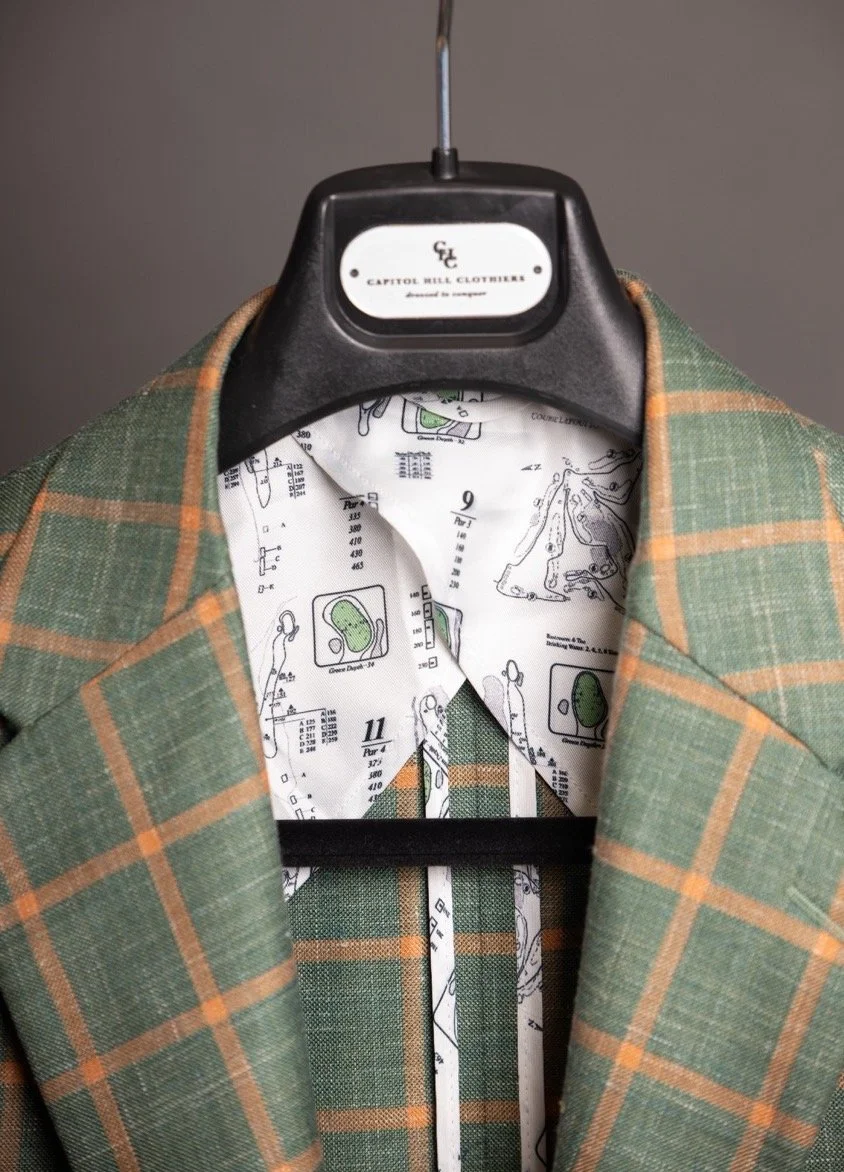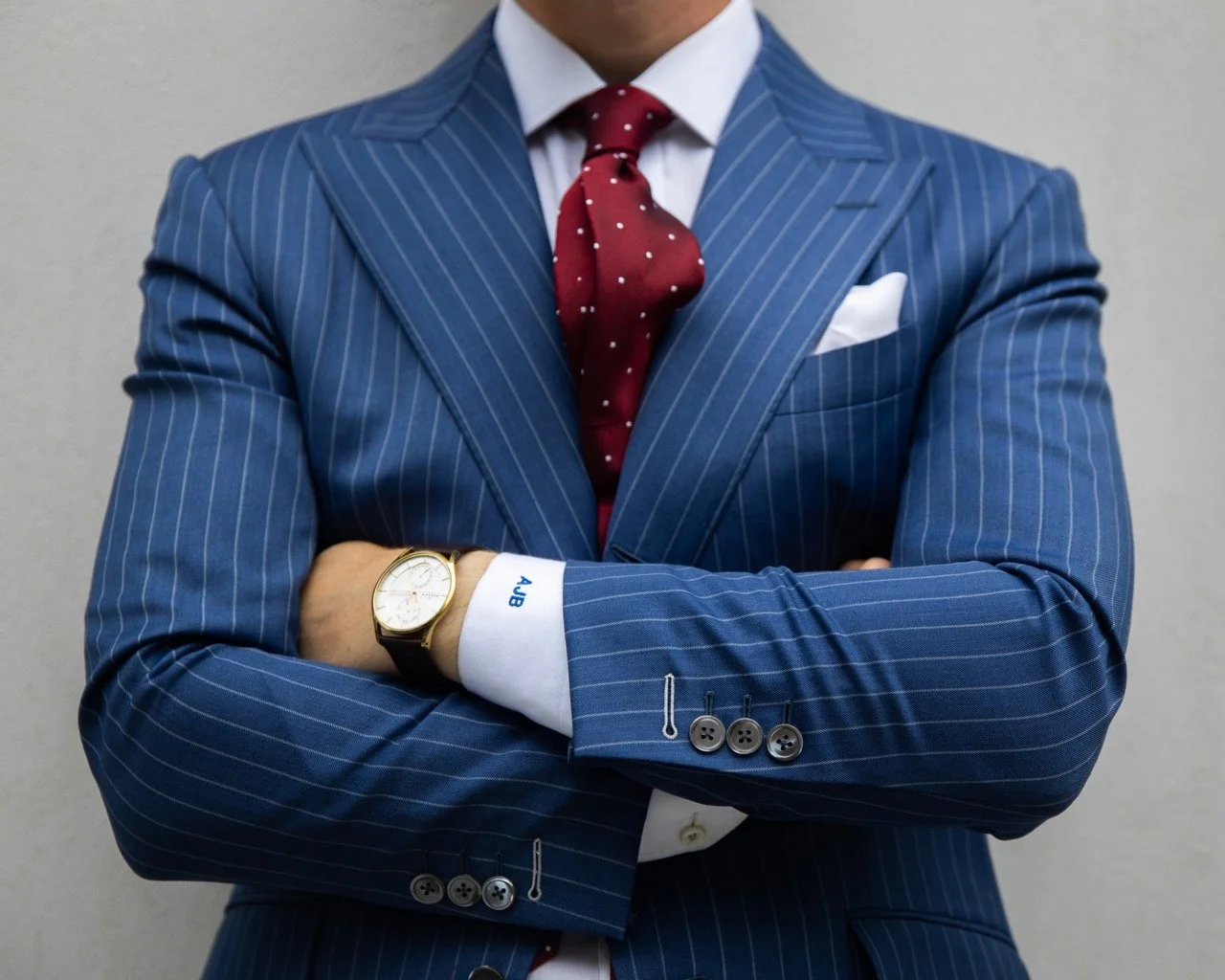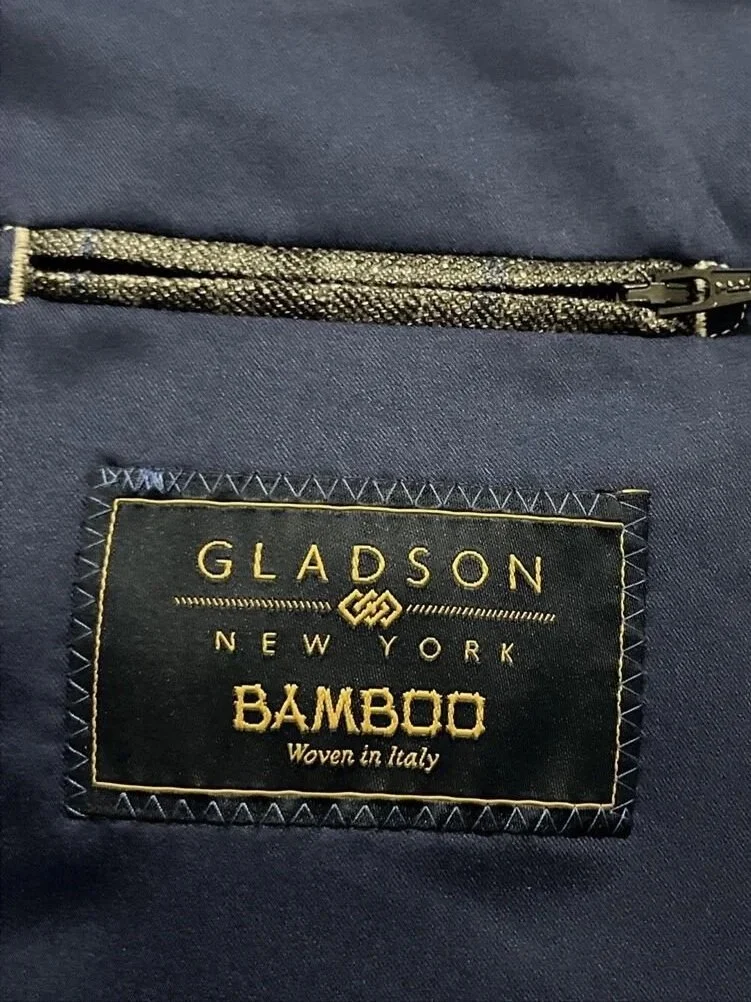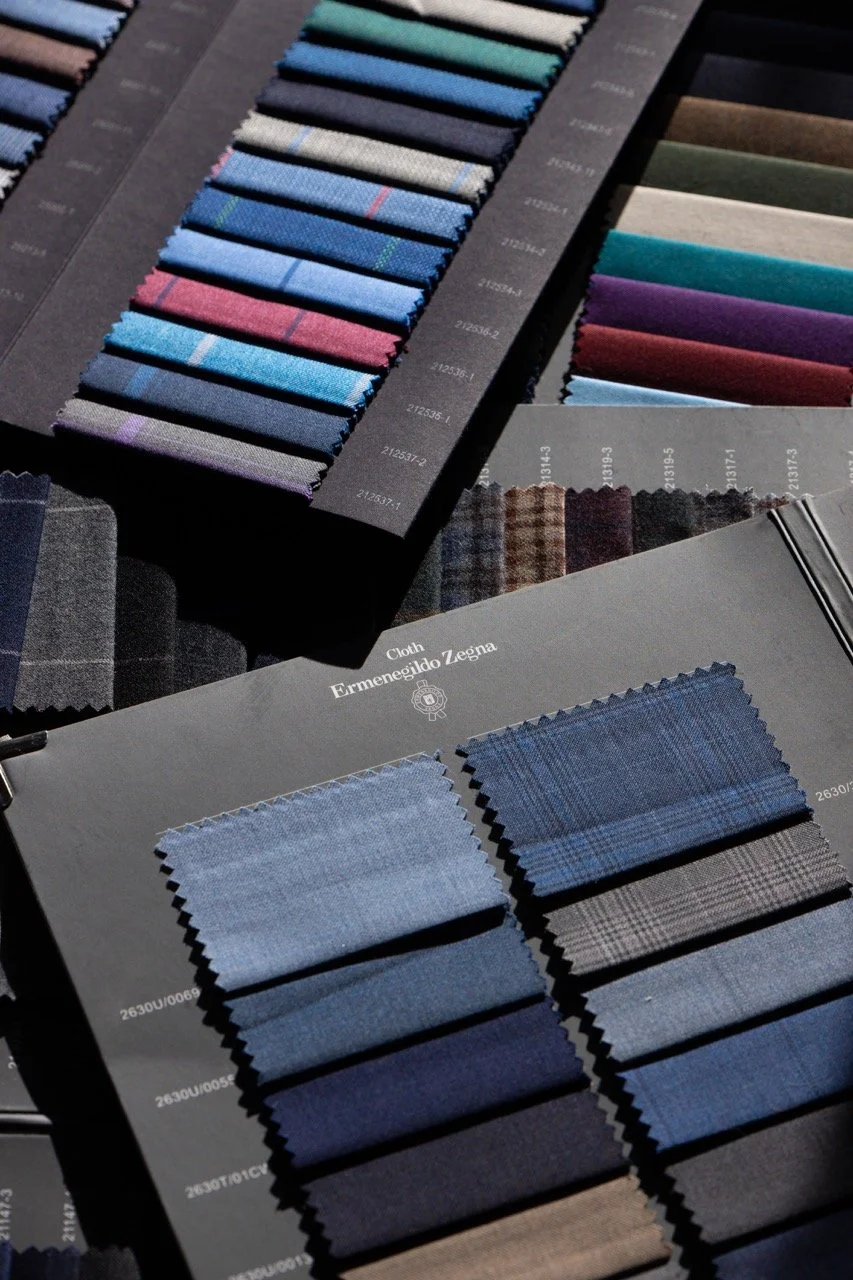2026 Suit Trends for Men
In the final months of 2025, Capitol Hill Clothiers has seen a decidedly passionate social shift in the direction of men in suits being the “superior” style (step aside, quarter zips). The modern man in 2026 wants to be perceived as desirable. A winner in his field. Confident and classy. There are a lot of suit styles that can maketh that man. Let’s go over the men’s suiting trends Capitol Hill Clothiers is forecasting for 2026 so you can get ahead of the game and enter the new year in style.
An unstructured wool, silk, and linen blend sport coat from Capitol Hill Clothiers
Silhouette and Fit: Structured or Non?
Across many fashion designers and style commentators, the big shift for men’s suits in 2026 is from tight, sculpted tailoring to “tailored-relaxed”: the suit still follows the body, but with more ease in the chest, shoulder, and thigh. Jackets often have slightly extended or dropped shoulders, deeper armholes, and a fuller chest, creating a stronger, more relaxed line rather than a shrunken, hyper-trim profile. Trousers move away from skinny and ultra-tapered cuts toward straight, wide, or gently tapered legs, sometimes with pleats added back for both comfort and a bit of movement in the fabric.
Structure: All or Nothing
As for structure, it truly seems to be all or nothing in 2026. The trend of “suits over quarter zips” has content creators showcasing very structured custom three-piece suits, custom double-breasted suits, and smartly layered custom blazers and sport coats. Structure in a suit jacket or sport coat helps to augment the traditional masculine silhouette, providing more broad shoulders to men (like me) who do not have the inverted triangle body type naturally. We’ll discuss how wide vs skinny lapels factor into this in a little bit as well. All told, structure is a deliberate style statement for younger men in 2026. Structured suits are being chosen with intention to exude a “look at me, I’m in a fucking suit” vibe.
Deconstruction also plays a role here. Many men prefer lighter canvassing or go completely unstructured, so the jacket feels closer to a shirt-jacket than body armor. This means the suit moves with the wearer and handles heat better, which is especially relevant in cities like Washington, DC with hot, humid summers. A different segment of the male populous than the above mentioned structure-hunters prefer function over everything. They want something breathable, lightweight, and most importantly, something they can treat like a more casual jacket, not have to baby it. The visual effect of a custom unstructured suit or jacket is fluid: when you walk, the jacket skirts and trouser legs have a slight swish rather than staying rigid. It reads as more casual and that’s in for some men in 2026.
Wide Lapels: Not Going Anywhere
Wide lapels have persisted as a staple for men over the last several years. They bridge the gap between classic menswear and the softer, swagger‑filled suiting that is emerging for 2026, giving jackets a stronger line without feeling costume‑y. In a world of relaxed silhouettes and wider trousers, a broader lapel visually balances the proportions of the torso, makes the chest look more substantial, and frames the face in a way that feels both modern and timeless. Whether the suit itself is sharply structured or softly draped, a generous notch or peak lapel immediately communicates intention and confidence rather than “generic business suit.”
One advantage of the current moment is how easy it is to access this look at different price points. Custom suits are ideal if you want to fine‑tune lapel width, shape, and roll to your frame. The lapel becomes a design lever you can pull: slightly wider on a single‑breasted suit for subtle impact, or full, sweeping peaks on a double‑breasted jacket when you want some drama.
Versatility is a big part of the appeal. Wide lapels look at home in traditional business tailoring, like on navy or charcoal suits with crisp shirts and a conservative tie, but they also pair naturally with the new, more relaxed language of suiting. Put them on an unstructured jacket in a textured fabric, style that with an open‑neck shirt or knit, and you still get a sense of polish without tipping into rigidity. The same lapel can sit on a formal tuxedo, a softly tailored sport coat, or a fashion‑forward suit worn with loafers and no tie, and in each case it reads as deliberate rather than showy.
A Custom pinstripe suit from Capitol Hill Clothiers with wide lapels
Because of that flexibility, wide lapels have effectively replaced skinny ones as a visual shorthand for contemporary masculinity in tailoring. On a double‑breasted suit they underscore the V‑shape of the torso and add a touch of cinematic glamour; on a single‑breasted sport coat they bring enough presence that you can keep everything else simple. The combination of stronger proportions, compatibility with relaxed fits, and their ability to flatter a wide range of body types is why they are increasingly treated as a long‑term baseline rather than a passing detail.
Why Slim Lapels Are A Thing Of The Past
Slim lapels, by contrast, are fading because they are tied very closely to a specific, mass‑market era of menswear. The ultra‑narrow lapels of the last two decades grew out of fast fashion’s need to simplify design, minimize fabric use, and sell a single, easy‑to‑replicate “modern” look at scale. The same aesthetic that gave us skinny jeans and tightly cut dress shirts pushed brands toward narrow lapels that could be stamped across millions of jackets with minimal variation. They were promoted as sleek and universally flattering, but in practice they were designed more for production efficiency and trend messaging than for long‑term style or durability.
This model depended heavily on the idea that one slim template could suit everyone. Marketing framed the slim lapel as the default for any man who wanted to look contemporary, which made it easier for big retailers to avoid engaging with different body types, proportions, or tastes. The result was a visual landscape dominated by tight jackets, thin lapels, and short coats that looked “sharp” in photos but often pulled at the button and restricted movement in real life. For many wearers, these pieces didn’t age well: they were made cheaply, dated quickly, and rarely invited the kind of care and repair that good tailoring deserves.
As menswear has matured, that homogenous slim‑lapel look has started to feel limiting rather than liberating. Narrow lapels don’t offer much room to play with proportion, texture, or layered styling, and on many bodies they can actually exaggerate imbalances by making shoulders look narrower and heads larger. Once the novelty wore off, people began to notice that these suits lacked the depth and adaptability of classic cuts: there was less opportunity to express personality, and the garments themselves were not built to develop character over time. In a culture that increasingly values individuality and longevity over disposability, that is a problem.
The broader shift toward relaxed silhouettes and richer, more personal suiting has made the shortcomings of slim‑lapel dominance more obvious. Compared with a spectrum of lapel widths and shapes, a single, very narrow option feels like a holdover from a trend‑driven, throwaway mindset. As men rediscover the possibilities of wider lapels, different buttoning points, and softer construction, the old “everything slim” formula looks less like a timeless ideal and more like a phase—one that defined early‑2000s menswear but ultimately left little room for the range of expression that tailoring can offer.
Styling by Layering
On the styling side, the major trend is “de-formalizing” the suit without making it look careless: think open collars, knits, and casual layering that still fits impeccably. Many Spring/Summer 2026 collections show tailored jackets over vintage-inspired V‑neck polos, fine-gauge crewnecks, or even sleek technical tops, which turns the suit into a versatile outfit rather than something reserved for court or a boardroom. Rolling up sleeves on soft-shouldered jackets, half-tucking shirts, or pairing suit trousers with relaxed outerwear (bombers, suede jackets) all signal that tailoring is part of daily style, not just formalwear. We all have Ralph Lauren’s persisting impact to thank for this.
Ties are not disappearing; they’re being treated more as a deliberate accessory. Trend reports reference “ties with a twist”: slimmer or slightly shorter proportions, unconventional textures, subtle patterns, or unexpected colors used with otherwise classic shirts and suits. Vests and waistcoats are also resurfacing as styling tools, sometimes matching the suit, sometimes in a contrasting color or texture. This lets you adjust formality by removing the jacket while still looking put together.
Layering is becoming lighter and more modular: shirt + knit vest + unstructured blazer, or polo + suit + very lightweight overcoat in a tonal or complementary color. This works especially well in transitional seasons or in climates where the day swings between muggy outdoors and cold offices, since each layer is thin but distinct. Because silhouettes are roomier, you can comfortably layer without feeling constricted, which wasn’t true in the ultra-slim era.
For someone who still needs to look professional, the practical move is to build a rotation of high-quality polos and fine sweaters in your best colors and to treat them as “shirt equivalents” under a suit. Keep at least one or two good silk or textured ties for days you need maximum authority, and use waistcoats or knit vests to vary how formal the same suit feels across different settings and seasons.
Sustainability Persists: NO POLYESTER
Sustainability is no longer a side note in tailoring; it is one of the central values shaping how consumers shop. As the industry reckons with its environmental footprint, more brands and clients are looking for cloth that respects both the body and the planet, rather than defaulting to purely cost‑driven synthetics. This is especially true in suiting, where fabric quality directly affects comfort, drape, and longevity. The direction is clear: fewer petroleum‑based fibers, more thoughtfully sourced natural ones, and a shift toward suits that are meant to be kept, altered, and worn for years rather than seasons.
Going into 2026 and beyond, the use of organic and natural materials in suiting continues to expand. Mills and makers are leaning into responsibly sourced wool, organic cotton, linen, hemp, and even bamboo blends as alternatives to the high‑polyester mixes that dominated value tailoring for so long. These fibers tend to breathe better, age more gracefully, and avoid some of the microplastic issues associated with conventional synthetics, which makes them attractive from both a comfort and an ecological standpoint. The result is a new generation of suits that feel lighter, move better with the body, and carry a smaller environmental burden over their lifecycle.
Anyone familiar with Capitol Hill Clothiers’ style philosophy already knows where the brand stands on synthetic fabrics. If not, check out our other Style Guides. From the start, the house position has been consistent: most synthetics, especially when used heavily in suiting, undermine both the tactile pleasure and long‑term performance that good tailoring should offer. They may be cheap and easy to mass‑produce, but they rarely deliver the same depth of color, breathability, or graceful aging as high‑quality natural fibers. That fundamental skepticism of disposable, plastic‑heavy suiting has only become more relevant as sustainability has moved to the center of the menswear conversation.
If this perspective is new to you, it is worth digging into the longer‑form style guides and essays below that unpack it in detail. Those pieces walk through why certain fibers feel better on the body, how different weaves behave in real‑world conditions like a D.C. summer, and what to look for when commissioning or buying a custom suit that will actually earn its place in your wardrobe. Taken together, they make the case that choosing organic or natural cloth is not just an environmental gesture, but also a practical decision about comfort, durability, and the kind of relationship you want to have with your clothes over time.
Should I Avoid Polyester in My Suits?
The Real Reason You’re Getting “Shocked” All Winter: Synthetic Fabrics
Dressing for Value: The Cost-Per-Wear Approach to Your Wardrobe
Colors and Fabrics: Your Creative Direction
Suit Fabric Color
Color in 2026 splits into two main directions: elevated neutrals and expressive, but controlled, brights or jewel tones. On the neutral side, there is a lot of beige, camel, stone, and sand; cooler greys; and soft earth tones like sage and taupe, often worn head-to-toe as tonal outfits. On the expressive side, predictions highlight deep reds, rich greens, bold blues, dusty rose, and similar hues, either as full suits for bolder dressers or as accent pieces like shirts, ties, or vests for everyone else.
Suit Fabric Texture
Fabrics are getting more interesting but staying wearable: knitted wools, tropical-weight suiting, brushed or matte finishes, micro-patterns like birdseye and herringbone, and subtle checks that only reveal themselves up close. For warm seasons, collections emphasize seersucker, cotton poplin, linen and linen blends, and ultralight wool or cotton blends designed to breathe and drape rather than cling. For cooler months, there is more use of velvet, mohair blends, and brushed wools to bring depth to evening and event suits without needing loud colors.
General Trends
Forecasters for Spring/Summer 2026 talk about “anti-heat” outfits: unlined or half-lined jackets, airy trousers, and natural fibers that can handle extreme temperatures while still reading as tailored. The color stories from textile forecasters skew toward sun-faded brights, relaxed beach neutrals, and nature-inspired greens and blues, which then get translated into real-world suiting by brands in more muted, office-appropriate tones. The goal is to look intentional and modern while still being able to commute, walk, and work without overheating.
In practice, a D.C.-area professional might keep navy and charcoal as the workhorses but start adding: one taupe or stone suit for spring/summer, one deep green or dark brown suit for fall/winter, and accessories in controlled brights (deep red, blue, or muted pink) that align with your color season. Choosing textured but not flashy fabrics—say, a navy birdseye, charcoal micro-check, or taupe hopsack—lets the suit photograph beautifully for headshots while subtly nodding to trend.
Color Analysis as a Tool
Before commissioning a custom suit, having a proper color analysis done is one of the most efficient ways to protect your investment and sharpen your overall presence. A well-cut suit in the wrong color will still fight your complexion, flatten your features, and make coordinating shirts and ties a constant struggle, while the right palette immediately makes your eyes clearer, your skin more even, and your wardrobe easier to build around. Knowing whether you sit better in cool charcoals or warm taupes, deep navies or softer blues, lets you choose cloth that works with you rather than against you, and ensures that every shirt, tie, sweater, etc. you buy slots in seamlessly instead of feeling like a one‑off.
Capitol Hill Clothiers builds this step directly into the process by offering a complimentary color analysis with their concierge suit fittings in the D.C. area, so by the time you are looking at swatches and lapels, you are already working from a curated range of shades that are tailored not just to your measurements, but to your natural coloring and the environments you move in.
Brand Loyalty: For Better or Worse
Brand loyalty has always shaped how men dress, but in the current cycle it exerts a stronger pull than ever. On the positive side, finding a house whose fit you like, cloth you trust, and aesthetic aligns with your vision can dramatically lower the friction of getting dressed. Once you know how a particular maker’s shoulders sit on you, how their rise and leg shape feel, and where their lapels and button stance hit, it becomes much easier to buy suits that require minimal second-guessing. For busy professionals, that kind of consistency is worth a lot: you trade the chaos of endless options for a smaller, more reliable ecosystem of designs that you know will work in your real life, season after season.
The complication is that social media rarely rewards quiet consistency. Platforms are built to amplify novelty and status signals, which means logos, recognizable silhouettes, and name‑brand labels tend to dominate the feed. Influencer culture and algorithmic curation push certain brands (Ralph Lauren Purple Label and Double RL are prime examples) into a kind of mythic territory, where owning a specific label is presented as the ultimate shortcut to taste, success, or “correct” style. For consumers, this can blur the line between genuine appreciation of a house’s design language and the desire to buy into a symbol that photographs well and reads instantly online. The risk is that the label becomes the goal, rather than fit, comfort, or how well the garment actually serves your life.
In practice, this dynamic can distort priorities. Men who might be better served by a well‑cut custom suit sometimes stretch their budgets to chase a marquee name that doesn’t actually fit their body or their day‑to‑day wardrobe needs. Others collect pieces from hyped labels that play well on Instagram but are difficult to integrate into a conservative office, courtroom, or client‑facing environment. The pressure to display certain tags can lead to closets full of expensive compromises: garments that satisfy the urge to belong to a particular brand tribe, yet fall short on the fundamentals of proportion, versatility, and long‑term wear.
None of this means brand loyalty is inherently bad; in many cases, it is a rational response to a confusing market. The key is to invert the usual order of thinking: start with your body, your coloring, and your actual lifestyle, then look for makers who consistently deliver on those needs, rather than starting with the logo and trying to force everything else to comply. When you approach loyalty this way, a label becomes a tool, not a master. You can still appreciate the romance of a storied house or the pleasure of a beautifully made signature piece, but your wardrobe decisions stay anchored in how garments feel, function, and age on you, not in how they perform in a 10‑second GRWM reel.
Must-Have Custom Suits for 2026
For 2026, the smartest “must‑have” custom suits are defined as much by fabric as by cut. Specifically, fabrics that both flatter your skin and hair and flex across different settings. The starting point is a year‑round wool in a shade that harmonizes with your natural coloring rather than fighting it: a deep, cool navy or charcoal for darker hair and higher contrast; softer mid‑greys, taupes, or blue‑greys for lighter or lower‑contrast features. In a well‑woven, breathable wool with a touch of texture like a subtle birdseye, pick‑and‑pick, or a fine twill. These read as solid at a distance but comes alive near the face, which is exactly where you want visual interest if you care about how you photograph or how present you look in a room.
Beyond that anchor, versatility comes from fabrics that can change character with how you style them. A textured neutral like a hopsack, wool‑linen, or wool‑silk blends in a carefully chosen taupe, olive, or deep brown can look sober with a white shirt and tie, then relaxed with a knit or chambray shirt. The key is picking a value (how light or dark it is) and undertone (warm vs cool) that echo your hair and sit comfortably against your skin, so the jacket works just as well over odd trousers or denim as it does as part of a full suit. When the cloth is in your best temperature and depth, you can rotate in different shirts and ties without the color story ever feeling disjointed.
A third fabric “must” for 2026 is an event cloth that’s expressive but still rooted in your palette—something like a deep green, midnight blue, ink purple, or rich chocolate in a smoother, slightly more lustrous weave. On cool, high‑contrast coloring, inky blues and blue‑greens are magnetic; on warmer or lower‑contrast coloring, complex browns, olives, and wine tones tend to be more forgiving and sophisticated. Choosing that event fabric in a weight and texture you can wear at more than one time of year maximizes its use: a crisp tropical wool or wool‑mohair for sharper, formal environments; a brushed or slightly matte finish if you prefer a softer, evening‑friendly feel.
When you approach “must‑have” suits this way—starting with your skin, eyes, and hair, then layering in fabric texture and color—you end up with a tight wardrobe of unique but highly versatile pieces. Each suit looks different on the hanger, but they all do the same job when you put them on: they light up your face, play nicely with your existing shirts and ties, and feel appropriate whether you are in a conservative office, a client dinner, or a more creative setting. That is where custom shines in 2026: not just in the pattern on the lapel, but in the quiet precision of choosing cloth that feels like it was designed for your coloring and your reality, not for a generic mannequin.








